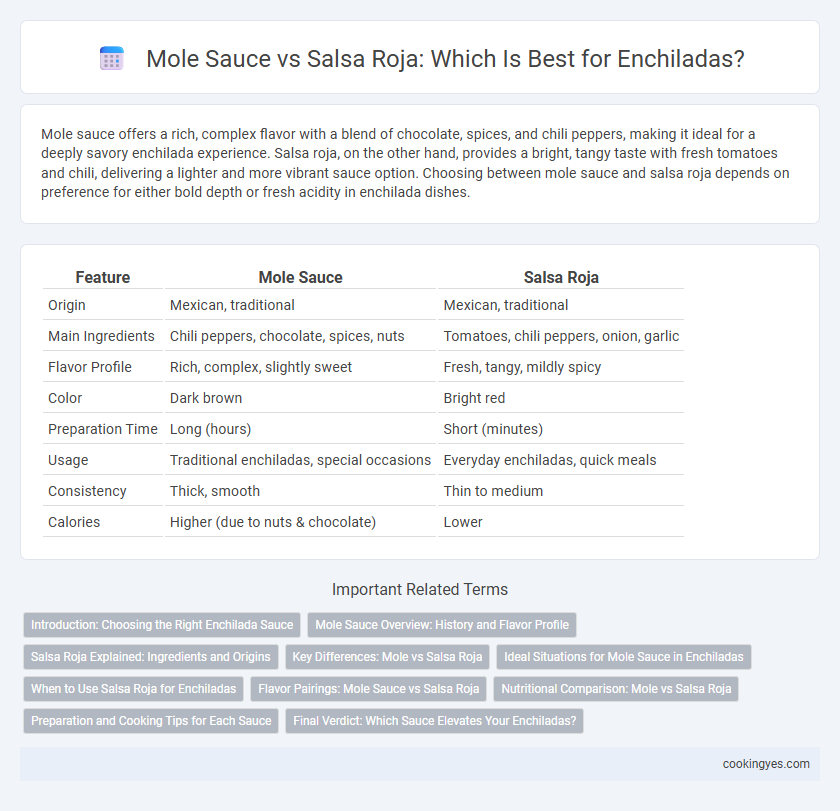Mole sauce offers a rich, complex flavor with a blend of chocolate, spices, and chili peppers, making it ideal for a deeply savory enchilada experience. Salsa roja, on the other hand, provides a bright, tangy taste with fresh tomatoes and chili, delivering a lighter and more vibrant sauce option. Choosing between mole sauce and salsa roja depends on preference for either bold depth or fresh acidity in enchilada dishes.
Table of Comparison
| Feature | Mole Sauce | Salsa Roja |
|---|---|---|
| Origin | Mexican, traditional | Mexican, traditional |
| Main Ingredients | Chili peppers, chocolate, spices, nuts | Tomatoes, chili peppers, onion, garlic |
| Flavor Profile | Rich, complex, slightly sweet | Fresh, tangy, mildly spicy |
| Color | Dark brown | Bright red |
| Preparation Time | Long (hours) | Short (minutes) |
| Usage | Traditional enchiladas, special occasions | Everyday enchiladas, quick meals |
| Consistency | Thick, smooth | Thin to medium |
| Calories | Higher (due to nuts & chocolate) | Lower |
Introduction: Choosing the Right Enchilada Sauce
Mole sauce offers a rich, complex flavor profile with ingredients like chocolate, chili peppers, and spices, making it ideal for enchiladas seeking depth and warmth. Salsa roja, made primarily from tomatoes, red chili peppers, garlic, and onions, provides a bright, tangy, and slightly spicy alternative that complements enchiladas with a fresher taste. Selecting between mole and salsa roja depends on the desired flavor intensity and regional authenticity for your enchilada dish.
Mole Sauce Overview: History and Flavor Profile
Mole sauce, a traditional Mexican blend with roots in pre-Hispanic culture, features complex layers combining chilies, spices, nuts, seeds, and chocolate, offering a rich and slightly sweet profile ideal for enchiladas. Unlike the simpler, tangier salsa roja made primarily from tomatoes and red chilies, mole provides depth and a robust balance of smoky, sweet, and savory flavors. Its historical significance and intricate preparation elevate enchiladas beyond a basic dish, making mole sauce a distinctive culinary experience.
Salsa Roja Explained: Ingredients and Origins
Salsa roja, a classic enchilada sauce, is made from roasted tomatoes, dried chilies like guajillo or ancho, garlic, onions, and spices, creating a rich yet balanced flavor profile. Originating from traditional Mexican cuisine, salsa roja offers a vibrant, mildly spicy taste that complements enchiladas without overpowering the dish. Its preparation emphasizes fresh, local ingredients, distinguishing it from the complex, chocolate-infused mole sauce which combines numerous spices and a thicker texture.
Key Differences: Mole vs Salsa Roja
Mole sauce for enchiladas is a complex blend of roasted chilies, spices, nuts, and chocolate, creating a rich, deep, and slightly sweet flavor profile. Salsa roja, made primarily from tomatoes, red chilies, garlic, and onions, offers a brighter, tangier, and more straightforward spicy taste. The key difference lies in mole's layered, savory complexity versus salsa roja's fresh and vibrant zest, shaping distinct enchilada experiences.
Ideal Situations for Mole Sauce in Enchiladas
Mole sauce is ideal for enchiladas when seeking a rich, complex flavor profile that combines chocolate, chilies, nuts, and spices, elevating the dish beyond traditional heat-driven options. Its thick, velvety texture complements hearty fillings such as shredded chicken, beef, or pork, making it perfect for festive occasions and special meals. Mole enchiladas suit those who appreciate layered, savory-sweet flavors and a distinctive Mexican culinary experience.
When to Use Salsa Roja for Enchiladas
Salsa roja is ideal for enchiladas when a fresh, tangy flavor with a mild to moderate heat level is desired, complementing the fillings without overpowering them. It works best with chicken or cheese enchiladas, offering a bright tomato base infused with chili peppers, garlic, and onions, enhancing the dish's vibrant colors and textures. Using salsa roja highlights the traditional Mexican taste, providing a lighter, more acidic contrast compared to the richer, spicier mole sauce.
Flavor Pairings: Mole Sauce vs Salsa Roja
Mole sauce offers a rich, complex flavor profile with ingredients like chocolate, chili peppers, and spices that create a deep, earthy complement to enchiladas, enhancing savory fillings such as chicken or beef. Salsa roja provides a bright, tangy, and mildly spicy taste made with tomatoes, garlic, and fresh chilies, which pairs well with cheese or vegetable enchiladas by adding a fresh, vibrant contrast. Choosing between mole sauce and salsa roja depends on whether a bold, layered taste or a lively, zesty flavor best suits the enchilada's ingredients and desired dining experience.
Nutritional Comparison: Mole vs Salsa Roja
Mole sauce is rich in antioxidants and contains a variety of ingredients like nuts, seeds, and dark chocolate, providing healthy fats and iron, but it is higher in calories and sugar compared to salsa roja. Salsa roja, made primarily from tomatoes, chilies, onions, and garlic, is lower in calories and sodium while offering a good source of vitamin C and lycopene. Choosing salsa roja supports a lighter, nutrient-dense option, whereas mole adds complex flavors along with a denser nutritional profile.
Preparation and Cooking Tips for Each Sauce
Mole sauce requires slow simmering of toasted spices, chili peppers, and chocolate to develop a deep, complex flavor, often benefiting from overnight resting to meld the ingredients thoroughly. Salsa roja is typically quicker to prepare, blending roasted tomatoes, garlic, and chili peppers, then simmering briefly to maintain its bright, fresh taste. For enchiladas, mole demands careful whisking to avoid clumping and a smooth finish, while salsa roja benefits from a balanced simmer to reduce acidity and enhance natural sweetness.
Final Verdict: Which Sauce Elevates Your Enchiladas?
Mole sauce elevates enchiladas with its complex blend of chocolate, chili, and spices, offering a rich, layered flavor profile that enhances traditional Mexican dishes. Salsa roja provides a fresh, tangy heat derived from roasted tomatoes, garlic, and chilies, creating a vibrant and slightly acidic complement. Choosing between mole and salsa roja depends on whether you prefer a deeply savory experience or a bright, spicy kick to elevate your enchiladas.
Mole sauce vs Salsa roja for enchilada sauce Infographic

 cookingyes.com
cookingyes.com